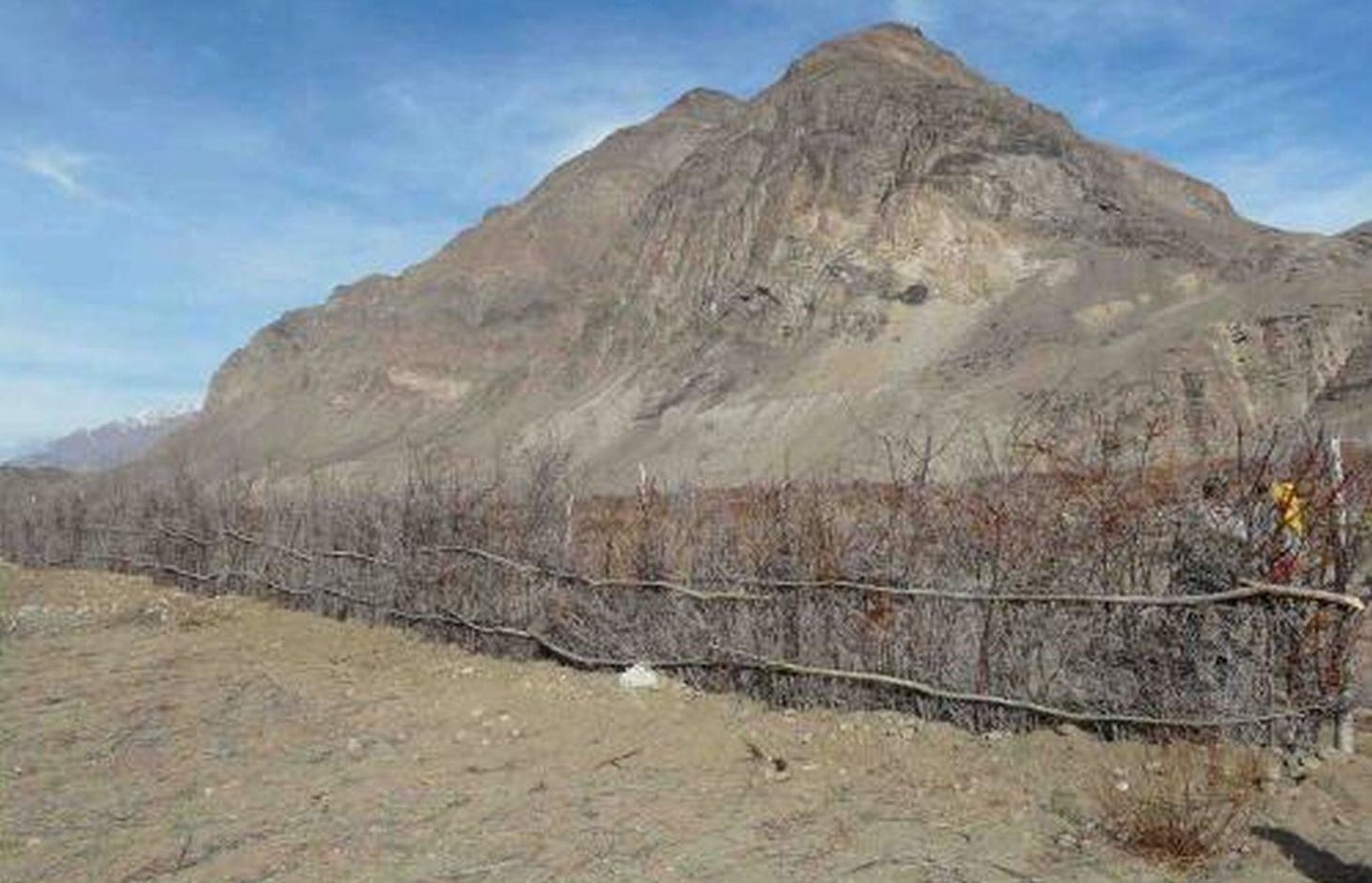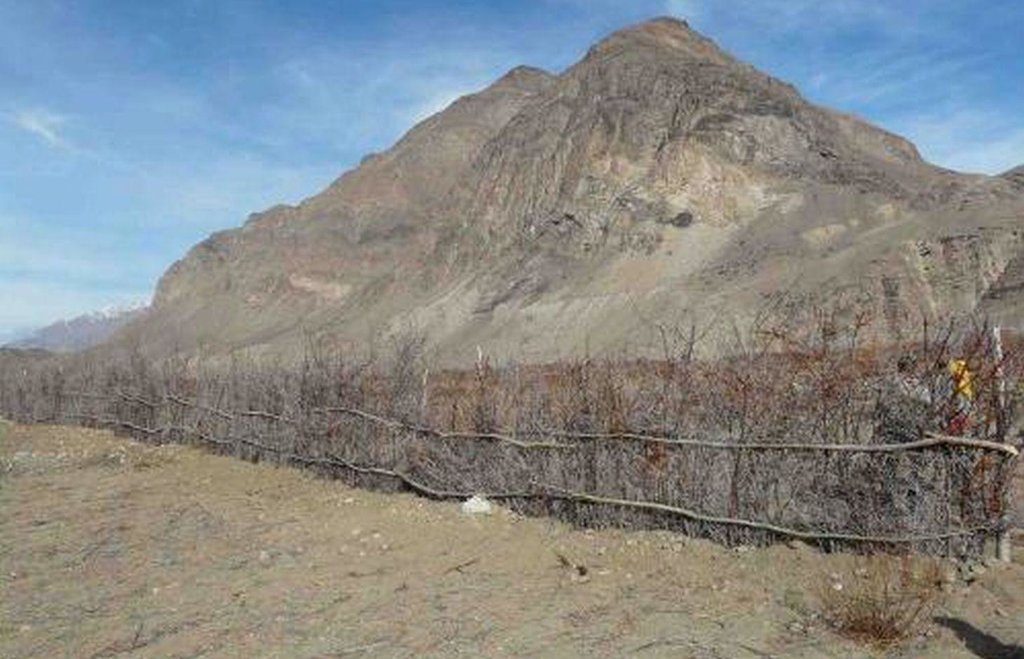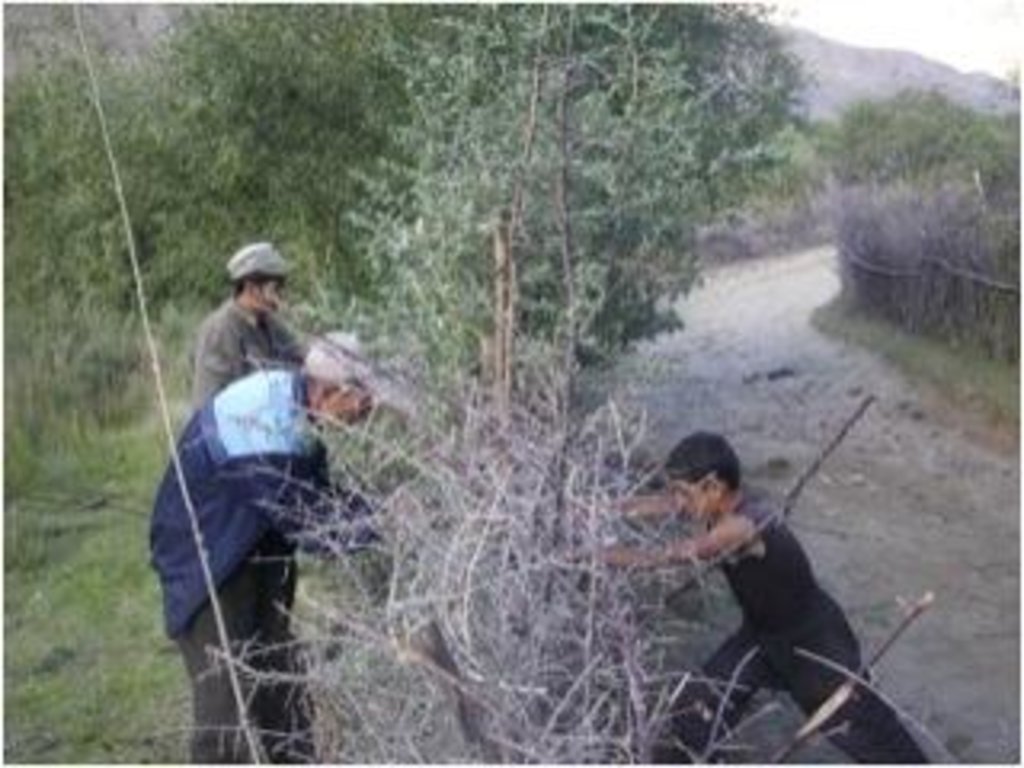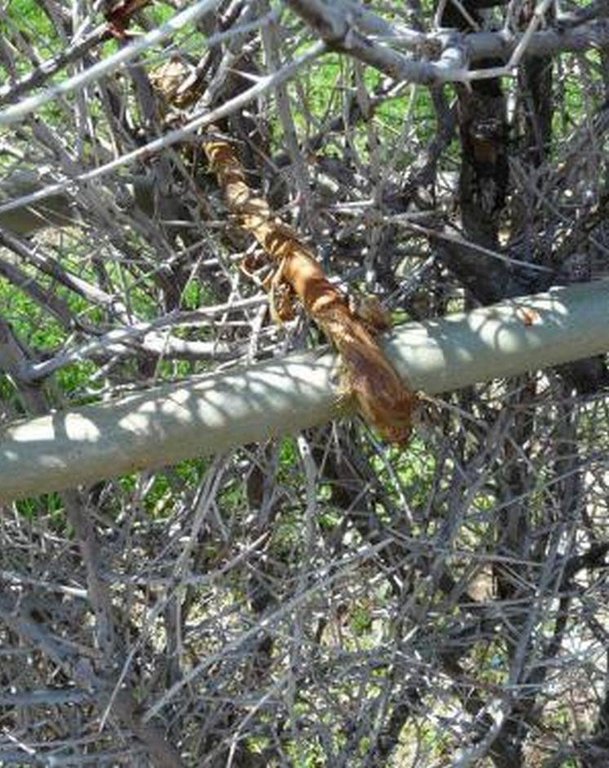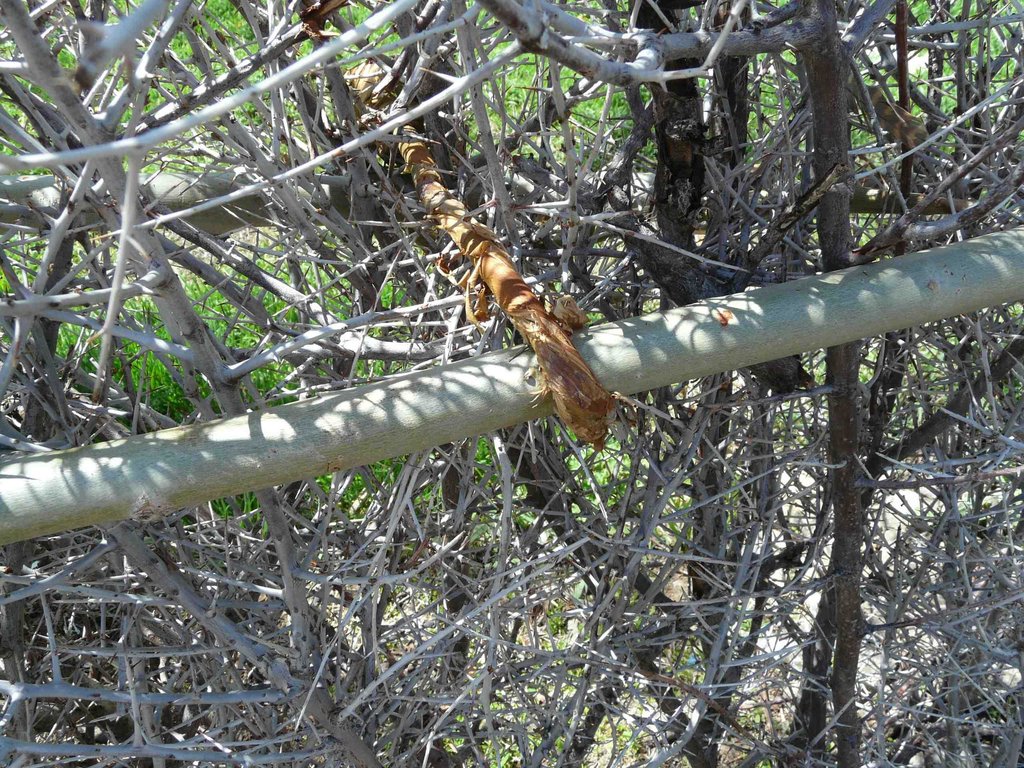Establishment of living seabuckthorn fences for the protection of reforestation sites (CACILM) [Tadjikistan]
- Création :
- Mise à jour :
- Compilateur : Roziya Kirgizbekova
- Rédacteur : –
- Examinateurs : Alexandra Gavilano, Fabian Ottiger
technologies_1036 - Tadjikistan
- Résumé complet en PDF
- Résumé complet en PDF pour impression
- Résumé complet dans le navigateur
- Résumé complet (non formaté)
- Establishment of living seabuckthorn fences for the protection of reforestation sites (CACILM): 27 décembre 2016 (inactive)
- Establishment of living seabuckthorn fences for the protection of reforestation sites (CACILM): 2 juin 2017 (inactive)
- Establishment of living seabuckthorn fences for the protection of reforestation sites (CACILM): 22 juillet 2017 (inactive)
- Establishment of living seabuckthorn fences for the protection of reforestation sites (CACILM): 14 août 2019 (public)
Voir les sections
Développer tout Réduire tout1. Informations générales
1.2 Coordonnées des personnes-ressources et des institutions impliquées dans l'évaluation et la documentation de la Technologie
Personne(s)-ressource(s) clé(s)
Spécialiste GDT:
Angermann Michael
+992 935 747318
michael.angermann@giz.de
Deutsche Gesellschaft für Internationale Zusammenarbeit (GIZ) GmbH,
Sustainable Management of Natural Resources in Gorno-Badakhshan, Okhonjon Str. 58-1, 736000 Khorog, Tajikistan,
Tadjikistan
Spécialiste GDT:
Neusel Benjamin
+992 935 747312
benjamin.neusel@cimonline.de
Deutsche Gesellschaft für Internationale Zusammenarbeit (GIZ) GmbH,
Sustainable Management of Natural Resources in Gorno-Badakhshan, Okhonjon Str. 58-1, 736000 Khorog, Tajikistan,
Tadjikistan
Spécialiste GDT:
Kirchhoff Joachim F.
+992 44 6006702
joachim.kirchhoff@giz.de
GIZ GmbH,
Regional Program on Sustainable Use of Natural Resources in Central Asia, Ayni Str./Nazarshoev Str., 734026 Dushanbe, Tajikistan
Nom du projet qui a facilité la documentation/ l'évaluation de la Technologie (si pertinent)
Central Asian Countries Initiative for Land Management (CACILM I)Nom du ou des institutions qui ont facilité la documentation/ l'évaluation de la Technologie (si pertinent)
Deutsche Gesellschaft für Internationale Zusammenarbeit (GIZ) GmbH (GIZ) - Allemagne1.3 Conditions relatives à l'utilisation par WOCAT des données documentées
Quand les données ont-elles été compilées (sur le terrain)?
03/05/2011
Le compilateur et la(les) personne(s) ressource(s) acceptent les conditions relatives à l'utilisation par WOCAT des données documentées:
Oui
2. Description de la Technologie de GDT
2.1 Courte description de la Technologie
Définition de la Technologie:
Protection of reforestation sites (willow, poplar and fruit trees) through living seabuckthorn perimeter fencing on Joint Forestry Management plots.
2.2 Description détaillée de la Technologie
Description:
In the heavily degraded flood plain forests of the Pamirs in eastern Tajikistan, living fences made out of seabuckthorn are protecting reforestation and Joint Forestry Management (JFM) sites. A living seabuckthorn fence consists of two layers. The outer layer is an instant fence made of thorny seabuсkthorn branches. The purpose of the outer layer is to immediately restrict animal and human access to the reafforestation site. The outer layer also buffers the inner layer of seabuckthorn, which is planted from seabuckthorn seedlings. The inner layer will establish itself over a number of seasons, eventually growing to a height of 1.5-2m. Once established, the seabuckthorn bush provides a low cost sustainable perimeter fence to protect reforestation activities. The bush also produces fruits for processing (in the frame of CACILM)
Purpose of the Technology: The purpose of this technology is to improve heavily degraded forest areas and establish new areas by restricting open access to the human population and preventing uncontrolled livestock grazing. As part of the Joint Forestry Management approach, these reforested areas are leased to the land user providing long-term legal control, as well as income opportunities for the tenants and the State Forestry Agency.
Establishment / maintenance activities and inputs: As part of the Joint Forestry Management approach (TAJ015), land is allocated by the State Forestry Agency to a designated land user. Once the size of the plot is established, a solid fence constructed of off-cuts of seabuckthorn and supported by willow poles is established around the perimeter of the JFM reforestation area. The seabuckthorn branches are fixed together with willow twigs, willow branches or wire and are attached to wooden poles. Once completed, seabuckthorn seedlings are planted at 0.5m intervals along a small irrigation channel on the inner side of the perimeter fence. After a few seasons these seedlings will grow into a natural living fence, which will take over the protection role from the perimeter fence constructed from off-cuts. The reforestion area is planted with branches of willow and poplar and interspersed with fruit trees. Reforestation planting materials are readily available in most parts of GBAO, and the Forestry Agency facilitates free access to seabuckthorn branches, willow branches and wooden poles. If required, wire and tools are provided by the JFM project.
Natural / human environment: The natural forest cover and biological diversity in many areas of GBAO has been significantly degraded. While population density in GBAO is low, natural resources are scarce due to the high altitude mountain environment and the pressure on these resources is great. In Soviet times, the Pamir region was highly dependent on subsidized coal from other parts of the Soviet Union. After independence, coal was no longer available and other fuel had to be sourced. Population pressure, poverty, and the lack of established local level institutions to manage forest lands have rendered forest areas an open access resource where the local population harvests forest products and grazes livestock without regulation. The local Forestry Agencies do not have the capacity to control overuse or to implement sustainable forestry management. As a part of the Joint Forestry Management approach (TAJ015) this SLM technology is a reintroduction of a traditional method for the protection of reforestation sites against livestock and, additionally, it clearly demarcates forest plot ownership and boundaries.
2.3 Photos de la Technologie
2.5 Pays/ région/ lieux où la Technologie a été appliquée et qui sont couverts par cette évaluation
Pays:
Tadjikistan
Région/ Etat/ Province:
Tajikistan, Gorno Badakhshan Autonomous Region (GBAO)
Autres spécifications du lieu:
Ishkashim, Roshtkala and Shugnan Districts
Map
×2.6 Date de mise en œuvre de la Technologie
Si l'année précise est inconnue, indiquez la date approximative: :
- il y a moins de 10 ans (récemment)
2.7 Introduction de la Technologie
Spécifiez comment la Technologie a été introduite: :
- par le biais de projets/ d'interventions extérieures
Commentaires (type de projet, etc.) :
Living seabuckthorn fencing is a traditional/indigenous method used for many years in the Pamirs. This technology has more recently been promoted by the project for the protection of forest plots under JFM. Similarly, the tree planting techniques used also follow traditionally applied methods in the Pamirs.
3. Classification de la Technologie de GDT
3.2 Type(s) actuel(s) d'utilisation des terres, là où la Technologie est appliquée

Forêts/ bois
Forêts (semi-)naturelles/ bois:
- Coupes sélectives
- plantation forestry
Produits et services:
- Bois d'œuvre (de construction)
- Bois de chauffage
- Fruits et noix
- Autres produits forestiers
- Conservation/ protection de la nature
- Protection contre les aléas naturels
Commentaires:
Major land use problems (compiler’s opinion): Open access to forests leads to illegal use and destruction of forests; grazing of livestock within forest areas hinder regeneration of forests.
Major land use problems (land users’ perception): Shortage of fuel wood for cooking and heating; lack of pastures and fodder for maintaining or increasing livestock herds; land degradation and increasing vulnerability to natural hazard periods
Selective felling of (semi-) natural forests: Yes
Plantation forestry: Yes
Problems / comments regarding forest use: For now most of the forest plots are strongly degraded natural and formerly forested areas. So far felling is strongly restricted and permitted only where afforestation is conducted.
Forest products and services: timber, fuelwood, fruits and nuts, other forest products / uses (honey, medical, etc.), nature conservation / protection, protection against natural hazards
Future (final) land use (after implementation of SLM Technology): Forests / woodlands: Fp: Plantations, afforestations
Si l'utilisation des terres a changé en raison de la mise en œuvre de la Technologie, indiquez l'utilisation des terres avant la mise en œuvre de la Technologie:
Mixed: Ms: Silvo-pastoralism
3.3 Informations complémentaires sur l'utilisation des terres
Nombre de période de croissance par an: :
- 1
Précisez:
Longest growing period in days: 100Longest growing period from month to month: May to July
3.5 Diffusion de la Technologie
Commentaires:
Total area covered by the SLM Technology is 20 m2.
3.6 Mesures de GDT constituant la Technologie

pratiques végétales
- V1: Couverture d’arbres et d’arbustes

modes de gestion
- M5: Contrôle/ changement de la composition des espèces
Commentaires:
Main measures: vegetative measures
Secondary measures: management measures
Type of vegetative measures: aligned: -along boundary
3.7 Principaux types de dégradation des terres traités par la Technologie

érosion éolienne des sols
- Et: perte de la couche superficielle des sols (couche arable)
- Eo: effets hors site de la dégradation

dégradation biologique
- Bc: réduction de la couverture végétale
- Bh: perte d’habitats
Commentaires:
Main causes of degradation: deforestation / removal of natural vegetation (incl. forest fires), over-exploitation of vegetation for domestic use, land tenure, governance / institutional (Lack of human and material resources of Forest Agency)
Secondary causes of degradation: overgrazing, population pressure, poverty / wealth, war and conflicts (Lack of energy resources during civil war)
3.8 Prévention, réduction de la dégradation ou réhabilitation des terres dégradées
Commentaires:
Main goals: rehabilitation / reclamation of denuded land
Secondary goals: prevention of land degradation, mitigation / reduction of land degradation
4. Spécifications techniques, activités, intrants et coûts de mise en œuvre
4.1 Dessin technique de la Technologie
Auteur:
Hahnewald/Gaude/Rosset
4.2 Spécification/ explications techniques du dessin technique
Living seabuckthorn fence: The dead part of the fence prevents livestock from entering the forest plot, while in the long run the planted seedlings take over this role by forming a dense living seabuckthorn barrier.
Location: -. Gorno Badakhshan, Tajikistan
Date: February 2011
Technical knowledge required for field staff / advisors: low
Technical knowledge required for land users: moderate (It is not a difficult technology to implement.)
Main technical functions: improvement of ground cover, stabilisation of soil (eg by tree roots against land slides), increase of biomass (quantity)
Secondary technical functions: increase / maintain water stored in soil, water harvesting / increase water supply, water spreading, reduction in wind speed, promotion of vegetation species and varieties (quality, eg palatable fodder)
Aligned: -along boundary
Vegetative material: T : trees / shrubs
Number of plants per (ha): 400-800
Vertical interval within rows / strips / blocks (m): 0.5
Trees/ shrubs species: seabuckthorn (Hippophae rhamnoides)
Change of land use type: Enclosure of the plot, change from grazing to forest
Change of land use practices / intensity level: Change from open access to controlled access (fence)
Control / change of species composition
4.3 Informations générales sur le calcul des intrants et des coûts
autre/ monnaie nationale (précisez):
Tajik Somoni
Indiquer le taux de change du dollars en monnaie locale (si pertinent): 1 USD= :
4,5
Indiquez le coût salarial moyen de la main d'œuvre par jour:
7.00
4.4 Activités de mise en place/ d'établissement
| Activité | Type de mesures | Calendrier | |
|---|---|---|---|
| 1. | Establishment of living seabuckthorn fence | Végétale | Any time |
| 2. | Planting of poplar and willows | Végétale | early spring |
| 3. | Planting of fruit trees | Végétale | early spring |
4.5 Coûts et intrants nécessaires à la mise en place
| Spécifiez les intrants | Unité | Quantité | Coûts par unité | Coût total par intrant | % des coût supporté par les exploitants des terres | |
|---|---|---|---|---|---|---|
| Main d'œuvre | Establishment of living seabuckthorn fence | Mandays | 160,0 | 6,6625 | 1066,0 | 100,0 |
| Main d'œuvre | Planting of poplar and willows | Mandays | 40,0 | 6,65 | 266,0 | 100,0 |
| Main d'œuvre | Planting of fruit trees | Mandays | 3,0 | 6,666 | 20,0 | 100,0 |
| Equipements | Tools | piece | 4,0 | 5,5 | 22,0 | |
| Matériel végétal | Seedlings Seabuckthorn | piece | 2000,0 | 0,2225 | 445,0 | |
| Matériel végétal | Seedlings of poplar and willows | piece | 1200,0 | 0,22166 | 265,99 | |
| Matériel végétal | Seedlings fruit trees | piece | 50,0 | 1,11 | 55,5 | 100,0 |
| Matériaux de construction | Wood | 360 cub per m | 1000,0 | 0,8 | 800,0 | |
| Matériaux de construction | Wire | m | 1000,0 | 0,111 | 111,0 | |
| Coût total de mise en place de la Technologie | 3051,49 | |||||
Commentaires:
Duration of establishment phase: 1 month(s)
4.6 Activités d'entretien/ récurrentes
| Activité | Type de mesures | Calendrier/ fréquence | |
|---|---|---|---|
| 1. | Fence repair | Végétale | spring, annually |
| 2. | Plant tending | Végétale | spring, annually |
4.7 Coûts et intrants nécessaires aux activités d'entretien/ récurrentes (par an)
| Spécifiez les intrants | Unité | Quantité | Coûts par unité | Coût total par intrant | % des coût supporté par les exploitants des terres | |
|---|---|---|---|---|---|---|
| Main d'œuvre | Fence repair | Mandays | 3,0 | 6,666 | 20,0 | 100,0 |
| Main d'œuvre | Plant tending | Mandays | 4,0 | 6,75 | 27,0 | 100,0 |
| Equipements | Tools | piece | 2,0 | 13,5 | 27,0 | |
| Matériel végétal | 8,0 | |||||
| Matériaux de construction | Wood | 2 cub per m | 1000,0 | 0,0089 | 8,9 | 100,0 |
| Matériaux de construction | Wire | meter | 10,0 | 0,1 | 1,0 | 100,0 |
| Coût total d'entretien de la Technologie | 83,9 | |||||
Commentaires:
Machinery/ tools: Spades, scissors, picks, gloves, planting bars.
The costs were calculated for 1000m of live seabuckthorn fence and approximately 1ha of tree planting, including 50 fruit trees and 1200 poplars and willows. Costs were calculated in April 2011. It is assumed that seabuckthorn and wood for poles are readily available on the forest plot or can be provided by the State Forestry Agency from nearby plots. Seedlings needed for the live part of the fence are very small parts of seabuckthorn plants, which are available as well wherever seabuckthorn grows. Tools are provided through the Joint Forestry Management project for the period they are needed for construction and maintenance. The mentioned enrichment plantings do not apply to every plot to the same extent. These also highly depend on the motivation and interest of the tenant.
4.8 Facteurs les plus importants affectant les coûts
Décrivez les facteurs les plus importants affectant les coûts :
The seabuckthorn seedlings are readily available in the area of implementation and incur no financial cost to the forest tenant. The labour is provided by the forest tenant. Labour is potentially a major expense if the land user must pay for it. Factors that contribute to the amount of labour required include the distance the seabuckthorn wood and seedlings have to be transported and the soil texture for the digging of a trench for the erection of the fence.
So far, the material needed for fencing and tree planting has been provided free of charge by the Forestry Agency. The only financial cost to the land user is the cost of the fruit trees, approximately 5 som per sapling. The land is provided by the Forestry Agency free of charge, however percentages of harvested forest products have to be paid to the Forestry Agency as the land owner's share.
5. Environnement naturel et humain
5.1 Climat
Précipitations annuelles
- < 250 mm
- 251-500 mm
- 501-750 mm
- 751-1000 mm
- 1001-1500 mm
- 1501-2000 mm
- 2001-3000 mm
- 3001-4000 mm
- > 4000 mm
Spécifications/ commentaires sur les précipitations:
Spring and autumn are (moderate) rainy seasons, summer is a dry period of min. 3 months
Zone agro-climatique
- aride
Thermal climate class: temperate. continental climate, cold winters but warm, rather long summers
5.2 Topographie
Pentes moyennes:
- plat (0-2 %)
- faible (3-5%)
- modéré (6-10%)
- onduleux (11-15%)
- vallonné (16-30%)
- raide (31-60%)
- très raide (>60%)
Reliefs:
- plateaux/ plaines
- crêtes
- flancs/ pentes de montagne
- flancs/ pentes de colline
- piémonts/ glacis (bas de pente)
- fonds de vallée/bas-fonds
Zones altitudinales:
- 0-100 m
- 101-500 m
- 501-1000 m
- 1001-1500 m
- 1501-2000 m
- 2001-2500 m
- 2501-3000 m
- 3001-4000 m
- > 4000 m
Indiquez si la Technologie est spécifiquement appliquée dans des:
- situations convexes
Commentaires et précisions supplémentaires sur la topographie:
Footslopes only where there is sufficient water coming from the gorges. Flood plain forests in the valley floors (convex). Flood plain forests in valley floors, flat areas.
5.3 Sols
Profondeur moyenne du sol:
- très superficiel (0-20 cm)
- superficiel (21-50 cm)
- modérément profond (51-80 cm)
- profond (81-120 cm)
- très profond (>120 cm)
Texture du sol (de la couche arable):
- grossier/ léger (sablonneux)
Matière organique de la couche arable:
- faible (<1%)
5.4 Disponibilité et qualité de l'eau
Profondeur estimée de l’eau dans le sol:
< 5 m
Disponibilité de l’eau de surface:
moyenne
Qualité de l’eau (non traitée):
eau potable
La salinité de l'eau est-elle un problème? :
Non
5.5 Biodiversité
Diversité des espèces:
- moyenne
5.6 Caractéristiques des exploitants des terres appliquant la Technologie
Orientation du système de production:
- subsistance (auto-approvisionnement)
- mixte (de subsistance/ commercial)
Revenus hors exploitation:
- > 50% de tous les revenus
Niveau relatif de richesse:
- pauvre
Individus ou groupes:
- individu/ ménage
Genre:
- hommes
Indiquez toute autre caractéristique pertinente des exploitants des terres:
Land users applying the Technology are mainly common / average land users
Difference in the involvement of women and men: Women are encouraged to participate, but as the work consists in rather strenuous forestry work, it is mainly applied by men.
Population density: < 10 persons/km2
Annual population growth: 1% - 2%
10% of the land users are average wealthy.
80% of the land users are poor (mostly villagers with no formal employment).
10% of the land users are poor.
Off-farm income specification: Mostly subsistence farming. Income mainly from remittances and formal employment.
5.7 Superficie moyenne des terres détenues ou louées par les exploitants appliquant la Technologie
- < 0,5 ha
- 0,5-1 ha
- 1-2 ha
- 2-5 ha
- 5-15 ha
- 15-50 ha
- 50-100 ha
- 100-500 ha
- 500-1 000 ha
- 1 000-10 000 ha
- > 10 000 ha
Cette superficie est-elle considérée comme de petite, moyenne ou grande dimension (en se référant au contexte local)?
- petite dimension
Commentaires:
Average area of land owned or leased by land users applying the Technology: 0.5-1 ha, 1-2 ha, 2-5 ha, 5-15 ha
5.8 Propriété foncière, droits d’utilisation des terres et de l'eau
Propriété foncière:
- état
Droits d’utilisation des terres:
- loué
Droits d’utilisation de l’eau:
- communautaire (organisé)
Commentaires:
Forest plots of the State Forestry Agency are leased to local forest tenants according to the procedure described in the approach TAJ015 "Joint Forestry Management". Therefore the tenants hold 20-years management and user rights specified in the contract for the leased plots. The technology is applied on these forest plots leased by the State Forestry Agency. Water use rights are strictly regulated on a communal basis, whereas use rights for forest plots have to be negotiated on a communal basis as well.
5.9 Accès aux services et aux infrastructures
santé:
- pauvre
- modéré
- bonne
éducation:
- pauvre
- modéré
- bonne
assistance technique:
- pauvre
- modéré
- bonne
emploi (par ex. hors exploitation):
- pauvre
- modéré
- bonne
marchés:
- pauvre
- modéré
- bonne
énergie:
- pauvre
- modéré
- bonne
routes et transports:
- pauvre
- modéré
- bonne
eau potable et assainissement:
- pauvre
- modéré
- bonne
services financiers:
- pauvre
- modéré
- bonne
6. Impacts et conclusions
6.1 Impacts sur site que la Technologie a montrés
Impacts socio-économiques
Production
production fourragère
production de bois
Quantité après la GDT:
2-10m3
Commentaires/ spécifiez:
Before: illegal open access
diversité des produits
Commentaires/ spécifiez:
non-timber forest products
production d'énergie
Disponibilité et qualité de l'eau
disponibilité de l'eau d'irrigation
Revenus et coûts
diversité des sources de revenus
Impacts socioculturels
sécurité alimentaire/ autosuffisance
situation sanitaire
connaissances sur la GDT/ dégradation des terres
situation des groupes socialement et économiquement désavantagés
Impacts écologiques
Cycle de l'eau/ ruissellement
ruissellement de surface
Sols
humidité du sol
couverture du sol
perte en sol
Biodiversité: végétale, animale
biomasse/ au dessus du sol C
diversité végétale
diversité des habitats
Réduction des risques de catastrophe et des risques climatiques
vitesse du vent
6.2 Impacts hors site que la Technologie a montrés
inondations en aval
sédiments (indésirables) transportés par le vent
6.3 Exposition et sensibilité de la Technologie aux changements progressifs et aux évènements extrêmes/catastrophes liés au climat (telles que perçues par les exploitants des terres)
Changements climatiques progressifs
Changements climatiques progressifs
| Saison | Type de changements/ extrêmes climatiques | Comment la Technologie fait-elle face à cela? | |
|---|---|---|---|
| températures annuelles | augmente | bien |
Extrêmes climatiques (catastrophes)
Catastrophes météorologiques
| Comment la Technologie fait-elle face à cela? | |
|---|---|
| pluie torrentielle locale | pas bien |
| tempête de vent locale | bien |
Catastrophes climatiques
| Comment la Technologie fait-elle face à cela? | |
|---|---|
| sécheresse | pas bien |
Catastrophes hydrologiques
| Comment la Technologie fait-elle face à cela? | |
|---|---|
| inondation générale (rivière) | pas bien |
Autres conséquences liées au climat
Autres conséquences liées au climat
| Comment la Technologie fait-elle face à cela? | |
|---|---|
| réduction de la période de croissance | pas bien |
6.4 Analyse coûts-bénéfices
Quels sont les bénéfices comparativement aux coûts de mise en place (du point de vue des exploitants des terres)?
Rentabilité à court terme:
légèrement négative
Rentabilité à long terme:
positive
Quels sont les bénéfices comparativement aux coûts d'entretien récurrents (du point de vue des exploitants des terres)?
Rentabilité à court terme:
neutre / équilibrée
Rentabilité à long terme:
positive
6.5 Adoption de la Technologie
- plus de 50%
Si disponible, quantifiez (nombre de ménages et/ou superficie couverte):
80% = 333 number of land user families / 85% of the area
Parmi tous ceux qui ont adopté la Technologie, combien d'entre eux l'ont fait spontanément, à savoir sans recevoir aucune incitation matérielle ou aucun paiement?
- 50-90%
Commentaires:
20% of land user families have adopted the Technology with external material support
83 land user families have adopted the Technology with external material support
Comments on acceptance with external material support: Material support was only provided where necessary inputs were not available but fencing nonetheless was crucial for the rehabilitation of the site.
80% of land user families have adopted the Technology without any external material support
333 land user families have adopted the Technology without any external material support
Comments on spontaneous adoption: For some forest areas a fence was established around the whole forest plot (not around each tenants individual plot), significantly reducing the workload as compared to the calculated costs.
There is a moderate trend towards spontaneous adoption of the Technology
6.7 Points forts/ avantages/ possibilités de la Technologie
| Points forts/ avantages/ possibilités du point de vue de l'exploitant des terres |
|---|
|
Ownership for a demarcated forest plot. How can they be sustained / enhanced? Support trust in the ownership among tenants, effective collaboration with the Forestry Agency. |
|
Increased income opportunities if regeneration of forests is improved, and legal access to fuelwood for subsistence. How can they be sustained / enhanced? Support the establishment of marketing opportunities. |
|
Technology is easy to implement and non-available materials are provided. How can they be sustained / enhanced? Encourage building of living seabuckthorn fences and provide access to places where building materials are available. |
| Points forts/ avantages/ possibilités du point de vue du compilateur ou d'une autre personne ressource clé |
|---|
|
Use of locally available material and indigenous species, therefore low level of external input. How can they be sustained / enhanced? Support availability and spatial distribution of seabuckthorn for fencing, establish nurseries for seabuckthorn seedlings. |
|
Implementation and promotion of traditionally used technology. How can they be sustained / enhanced? Training to show advantages and sustainability of the traditional fencing technique. |
|
Effective protection of forest areas, protection of planted seedlings, support of natural regeneration. How can they be sustained / enhanced? Support the establishment of marketing opportunities for forest products and highlight the increased income and harvest opportunities if forests are protected and growing well. |
|
Sustainability through the planting of seabuckthorn seedlings and the evolution towards a living seabuckthorn fence. How can they be sustained / enhanced? Highlight the lower maintenance costs once the fence is naturally growing and dense. |
|
Potential for further processing of seabuckthorn. How can they be sustained / enhanced? Support the establishment of sustainable and market-oriented structures for seabuckthorn and other NTFP processing. |
6.8 Faiblesses/ inconvénients/ risques de la Technologie et moyens de les surmonter
| Faiblesses/ inconvénients/ risques du point de vue de l’exploitant des terres | Comment peuvent-ils être surmontés? |
|---|---|
| Livestock cannot be grazed on forest areas. | Trainings and participatory discussions on opportunities to increase fodder and pasture availability, including "cut and carry" systems and increased production of perennial and other fodder crops within the forest plots. |
| High workload for fencing and planting. | Highlight the longterm income and subsistence opportunities when increased amounts of forest products can be harvested and support the creation of value chains and marketing options for forest products. |
| Faiblesses/ inconvénients/ risques du point de vue du compilateur ou d'une autre personne ressource clé | Comment peuvent-ils être surmontés? |
|---|---|
| Conflicts might arise within the village between the interest of protecting and supporting regeneration of the forest and the interest of villagers to graze their livestock on the forest plots. | Facilitation of integrated land management including forestry, pasture management and irrigation; facilitation of civil society organization formation. |
Liens et modules
Développer tout Réduire toutLiens
Aucun lien
Modules
Aucun module trouvé


